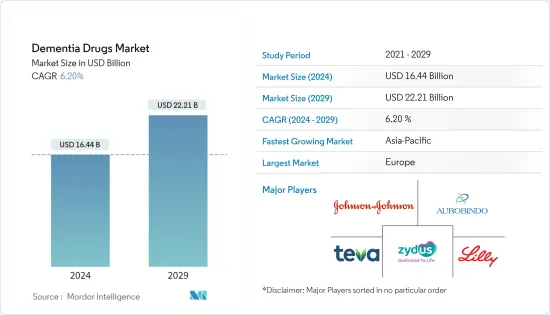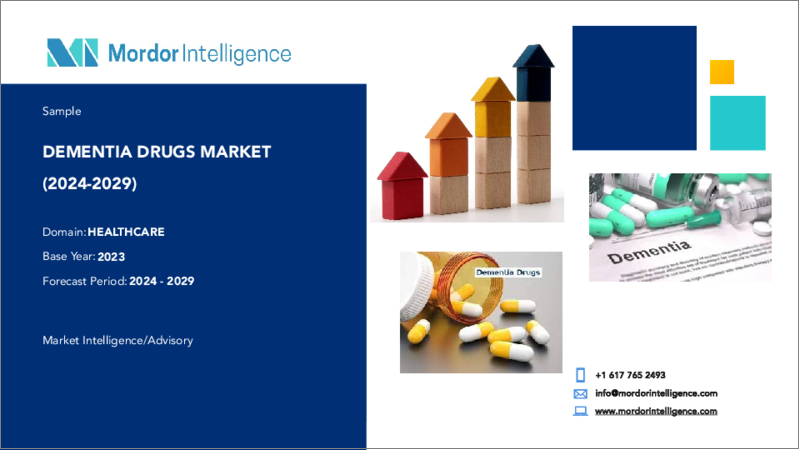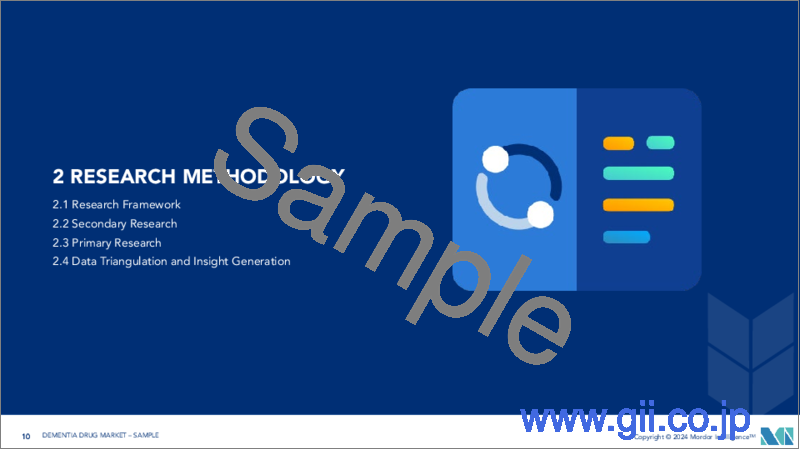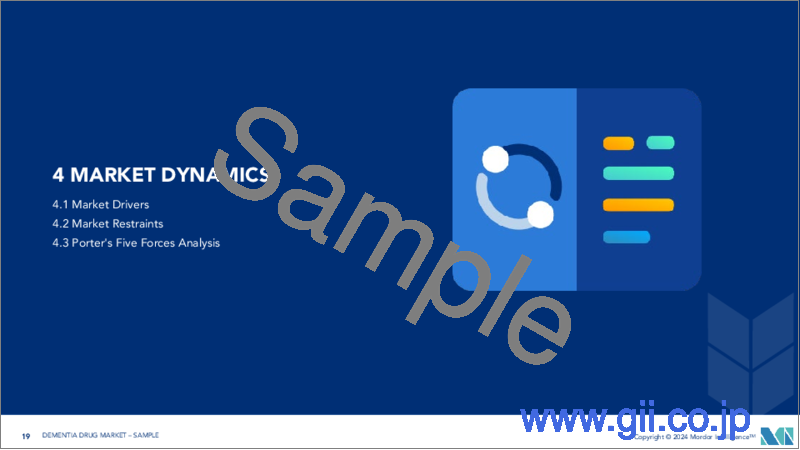|
|
市場調査レポート
商品コード
1439788
認知症治療薬:市場シェア分析、産業動向と統計、成長予測(2024年~2029年)Dementia Drugs - Market Share Analysis, Industry Trends & Statistics, Growth Forecasts (2024 - 2029) |
||||||
|
● お客様のご希望に応じて、既存データの加工や未掲載情報(例:国別セグメント)の追加などの対応が可能です。 詳細はお問い合わせください。 |
|||||||
| 認知症治療薬:市場シェア分析、産業動向と統計、成長予測(2024年~2029年) |
|
出版日: 2024年02月15日
発行: Mordor Intelligence
ページ情報: 英文 125 Pages
納期: 2~3営業日
|
- 全表示
- 概要
- 目次
認知症治療薬の市場規模は、2024年に164億4,000万米ドルと推定され、2029年には222億1,000万米ドルに達すると予測され、予測期間(2024~2029年)のCAGRは6.20%で成長する見込みです。

COVID-19パンデミックの発生は認知症治療薬市場に大きな影響を与えました。一部の国では、認知症患者への薬物療法の提供に大きな混乱が生じました。2021年10月にAlzheimer's and Dementiaに発表された調査によると、月間販売量の68.6%が前年比で増加しました。封鎖が始まった2020年3月には、欧米34カ国で消費量が82.3%増加しました。販売量はパンデミック前の期間に増加し、最も顕著な急増は3月に起こりました。パンデミック期間中、4月と5月の使用量は減少しましたが、6月には増加しました。したがって、COVID-19は市場の成長に大きな影響を与えました。しかし、規制が解除されて以来、業界は順調に回復しています。過去2年間、認知症の高い有病率と新製品の発売が市場の回復を牽引してきました。
市場成長を後押ししている要因は、対象疾患の有病率の増加、新しく革新的な技術や医薬品のイントロダクション、認知症に対する政府の資金援助や啓発プログラムの増加です。世界保健機関(WHO)によると、2022年9月には世界で約5,500万人が認知症に罹患しており、60%以上が低・中所得国に居住しています。実質的にすべての国で65歳以上の人口の割合が増加しているため、この数字は2030年には7,800万人、2050年には1億3,900万人になると予測されています。このように、世界中で認知症の有病率が高まっていることが、市場の成長を後押しすると予想されます。
政府の資金援助と認知度向上プログラムの増加は、市場の成長を促す主な要因です。例えば、2022年2月の最新情報によると、McGill大学の認知症教育プログラムによる新たな取り組みが、認知症に対する認識を高め、認知症を含むコミュニティを促進するためにカナダ公衆衛生局から資金提供を受ける15のプロジェクトの中に含まれています。さらに、2021年10月、インドのケララ州政府は、認知症にやさしい地区プログラム"Udbodh"を開始しました。このプログラムは、コーチン科学技術大学の神経科学部門、エルナクラム地区行政、コーチン市公社と協力して実施されました。さらに、2021年1月には、欧州を代表するライフサイエンス投資家であるLSPが、神経変性疾患対策に特化した基金「LSP認知症基金」を立ち上げました。こうした取り組みは認知症に対する認識を高め、ひいては医薬品や治療法の普及につながり、市場の成長に寄与します。
さらに、2021年8月、米国国立衛生研究所(NIH)は、薬物誘発性認知症を調査し、アルツハイマー研究を推進する新しいモデルを開発するため、Tabula Rasa HealthCare Inc.とHesperos Inc.に190万米ドルの資金を授与しました。公的機関からのこうした支援も市場の成長に寄与しています。
したがって、予測期間中、市場は成長を予測されます。しかし、承認段階での薬剤の高い失敗率が、予測期間中の市場成長を阻害すると予想されます。
認知症治療薬の市場動向
アルツハイマー病領域が大きな市場シェアを占め、予測期間中もその傾向が続くと予測される
アルツハイマー病領域は、アルツハイマー病に対する負担の増加やアルツハイマー病治療薬の研究開発の進行などの要因により、予測期間中も大きな市場シェアを維持するとみられます。
アルツハイマー病患者のための効果的な治療薬を開発するための研究開発活動に対する企業の重点の高まりは、予測期間中の同分野の成長を促進すると予想されます。例えば、Alzheimer's Association 2021の報告書によると、米国食品医薬品局(FDA)は、アルツハイマー病の治療薬として、リバスチグミン、ガランタミン、ドネペジル、メマンチン、メマンチンとドネペジルの組み合わせの5剤を承認しました。同じ情報源によれば、アルツハイマー型認知症を発症する人の大多数は65歳以上です。これは晩発性アルツハイマーと呼ばれます。米国では、65歳から74歳のほぼ5.3%、75歳から84歳の13.8%、85歳以上の34.6%がアルツハイマー型認知症です。さらに、2021年には65歳以上のアメリカ人のうち620万人がアルツハイマー型認知症を患っていると推定され、2050年には1,350万人に達すると予測されています。このような高い有病率は、今後数年間、患者集団における認知症治療薬の需要を高めると予想されます。
さらに、複数の市場プレーヤーが戦略的開拓に取り組んでおり、市場成長に貢献しています。例えば、2021年6月、米国食品医薬品局はアルツハイマー病の治療薬としてAduhelm(アデュカヌマブ)を承認しました。
このように、上記のような進展と疾患負担の増大が相まって、同分野は予測期間中に大きな成長を遂げることが予想されます。
欧州地域が市場の主要シェアを占めており、予測期間中もその傾向が続くと予想される
欧州地域は、英国やドイツのような国々における神経疾患の負担増加、この業界で事業を展開する市場開拓企業による戦略的開発の成長、政府のイニシアチブの増加などの要因により、予測期間を通じて主要な市場シェアを維持すると予想されます。
英国政府による2022年2月の更新によると、2020年の英国における認知症およびアルツハイマー病の推定診断率は62.4%であり、この数字は、英国内での患者数の増加を示しており、ひいては英国における認知症治療薬の需要を牽引しています。
さらに、2021年国家認知症戦略によると、ドイツでは2020年に160万人が認知症を患っています。同出典によると、認知症は25世帯に1人が罹患しており、2050年には推定280万人に増加すると予想されています。このように、欧州人口の認知症罹患率の増加は、欧州地域における認知症治療薬の需要を促進し、市場の成長に寄与すると考えられます。
さらに、ドイツ政府によるイニシアチブの増加も市場の成長に寄与しています。例えば、2020年7月に採択された「国家認知症戦略」に従い、ドイツ政府は認知症患者の生活環境を持続的に改善し、将来に向けて持続可能な構造を構築するための取り組みを行っています。このような動きは、認知症に関連する研究開発活動を促進し、同国における認知症治療薬の開発をさらに後押しし、市場成長に貢献すると期待されます。
さらに、2021年2月、Exscientiaは、アルツハイマー病治療のための神経炎症を標的とした医薬品を開発するため、Alzheimer's Research United Kingdom University of Oxford Drug Discovery Institute(ARUK-ODDI)と提携しました。企業活動の活発化や提携・協力などの事業戦略の採用は、認知症治療薬の需要を増加させ、同地域の市場成長を後押しすると予想されます。
このように、同市場は上記の要因により、予測期間中に大きな成長を遂げると予想されます。
認知症治療薬産業の概要
認知症治療薬市場は適度な競争状態にあり、ローカルプレイヤーとグローバルプレイヤーで構成されています。主なプレーヤーは、市場での地位を高めるために、新製品開拓、提携、M&Aなどの戦略的提携に投資しています。市場の主要企業には、Apotex Inc.、AstraZeneca、Aurobindo Pharma、Eisai、Eli Lilly and Company、Johnson &Johnson、Pfizer Inc.、Teva Pharmaceuticals、Zydus Cadilaなどがあります。
その他の特典:
- エクセル形式の市場予測(ME)シート
- 3ヶ月間のアナリストサポート
目次
第1章 イントロダクション
- 調査の前提条件と市場定義
- 調査範囲
第2章 調査手法
第3章 エグゼクティブサマリー
第4章 市場力学
- 市場概要
- 市場促進要因
- 対象疾患の有病率の増加
- 革新的な新技術・新薬のイントロダクション
- 政府による資金援助と啓発プログラムの増加
- 市場抑制要因
- 承認段階での医薬品の高い失敗率
- ポーターのファイブフォース分析
- 新規参入業者の脅威
- 買い手/消費者の交渉力
- 供給企業の交渉力
- 代替品の脅威
- 競争企業間の敵対関係の強さ
第5章 市場セグメンテーション(市場規模:金額ベース)
- 適応症別
- レビー小体型認知症
- パーキンソン病認知症
- アルツハイマー型認知症
- 血管性認知症
- その他の適応症
- 薬剤クラス別
- MAO阻害薬
- グルタミン酸阻害薬
- コリンエステラーゼ阻害薬
- 地域別
- 北米
- 米国
- カナダ
- メキシコ
- 欧州
- ドイツ
- 英国
- フランス
- イタリア
- スペイン
- その他欧州
- アジア太平洋
- 中国
- 日本
- インド
- オーストラリア
- 韓国
- その他アジア太平洋
- 中東・アフリカ
- GCC
- 南アフリカ
- その他中東・アフリカ
- 南米
- ブラジル
- アルゼンチン
- その他南米
- 北米
第6章 競合情勢
- 企業プロファイル
- SK Capital(Apotex Pharmaceutical Holdings Inc.)
- AstraZeneca
- Aurobindo Pharma
- Eisai Co. Ltd
- Eli Lilly and Company
- Johnson and Johnson
- Pfizer Inc.
- Teva Pharmaceuticals
- Zydus Cadila
- Athira Pharma
- Annovis Bio
- Biogen
- GlaxoSmithKline PLC
- Merck & Co. Inc.
第7章 市場機会と今後の動向
The Dementia Drugs Market size is estimated at USD 16.44 billion in 2024, and is expected to reach USD 22.21 billion by 2029, growing at a CAGR of 6.20% during the forecast period (2024-2029).

The outbreak of the COVID-19 pandemic had a considerable impact on the dementia drugs market. Certain countries saw significant disruptions in the delivery of pharmacological therapy to dementia patients. According to a study published in Alzheimer's and Dementia in October 2021, 68.6% of monthly sales volume increased compared to the prior year. In March 2020, the month the lockdown began, countries increased consumption volume by 82.3% in 34 European and North American countries. Sales climbed during the pre-pandemic period, with the most obvious spike occurring in March. During the pandemic, use was lower in April and May but increased in June. Hence, COVID-19 significantly impacted the market's growth. However, since the restrictions were lifted, the industry has been recovering well. Over the last two years, the market recovery has been led by the high prevalence of dementia and new product launches.
The factors propelling the market growth are the increasing prevalence of target diseases, the introduction of new and innovative technologies and drugs, and increased government funding and awareness programs for dementia. According to the World Health Organization, in September 2022, around 55 million individuals worldwide had dementia, with more than 60% residing in low- and middle-income counties. As the proportion of the population over the age of 65 years rises in practically every country, this figure is predicted to climb to 78 million in 2030 and 139 million in 2050. Thus, the growing prevalence of dementia worldwide is expected to boost the market's growth.
Increased government funding and awareness programs are the major factors driving the market's growth. For instance, as per a February 2022 update, a new initiative by McGill University's Dementia Education Program was among the 15 projects that would receive funding from the Public Health Agency of Canada to raise awareness of dementia and promote dementia-inclusive communities. Additionally, in October 2021, the Government of Kerala, India, launched the Dementia-Friendly District program, "Udbodh." This program was undertaken in cooperation with the NeuroScience department at Cochin University of Science and Technology, the Ernakulam district administration, and the Kochi Municipal Corporation. Moreover, in January 2021, LSP, the leading European life sciences investor, launched the LSP Dementia Fund, a fund dedicated to combating neurodegenerative diseases. Such initiatives will boost the awareness of dementia and, ultimately, drugs and treatments, thereby contributing to market growth.
Additionally, in August 2021, the National Institutes of Health (NIH) awarded USD 1.9 million in funding to Tabula Rasa HealthCare Inc. and Hesperos Inc. to investigate drug-induced dementia and develop new models that will drive Alzheimer's research. Such support from public organizations also contributes to the market's growth.
Thus, the market is expected to project growth over the forecast period. However, the high failure rates of drugs at the approval stages are expected to impede market growth over the forecast period.
Dementia Drugs Market Trends
The Alzheimer's Disease Segment Hold a Significant Market Share and is Expected to Continue the Same Over the Forecast Period
The Alzheimer's disease segment is expected to hold a major market share over the forecast period owing to factors such as the increasing burden of Alzheimer's disease and ongoing research & development of drugs for Alzheimer's.
The increasing company focus on research & development activities for developing effective treatment drugs for patients with Alzheimer's disease is expected to drive the segment growth over the forecast period. For instance, as per the Alzheimer's Association 2021 report, the United States Food and Drug Administration (FDA) approved five drugs for treating Alzheimer's, namely rivastigmine, galantamine, donepezil, memantine, and memantine combined with donepezil. As per the same source, the vast majority of people who develop Alzheimer's dementia are aged 65 years or older. This is called late-onset Alzheimer's. In the United States, nearly 5.3% of people aged 65 to 74 years, 13.8% of people aged 75 to 84 years, and 34.6% of people aged 85 years or older have Alzheimer's dementia. Additionally, an estimated 6.2 million Americans aged 65 years and older were living with Alzheimer's dementia in 2021 and are projected to reach 13.5 million by 2050. Such a high prevalence of the disease is anticipated to bolster the demand for dementia drugs among the patient population over the coming years.
Moreover, several market players are engaged in implementing strategic developments, contributing to market growth. For instance, in June 2021, the United States Food and Drug Administration approved Aduhelm (aducanumab) to treat Alzheimer's.
Thus, due to the above-mentioned developments coupled with the growing burden of the disease, the segment is expected to witness significant growth over the forecast period.
The European Region Holds the Major Share in the Market and is Expected to Continue the Same Over the Forecast Period
The European region is expected to hold a major market share throughout the forecast period owing to factors such as the increasing burden of neurological disorders in countries like the United Kingdom and Germany, the growth in strategic development by the market players operating in the industry, and increasing government initiatives.
As per a February 2022 update by the United Kingdom government, the estimated dementia and Alzheimer's diagnosis rate was 62.4% in the United Kingdom in 2020, thus, this number indicates the increasing patient pool within the country, which, in turn, drives the demand for dementia drugs in the United Kingdom.
Furthermore, as per the 2021 National Dementia Strategy, in Germany, 1.6 million people were living with dementia in 2020. As per the same source, dementia affects one person in every 25 households, and the number is expected to increase to an estimated 2.8 million people by 2050. Thus, the increasing incidences of dementia among the European population are likely to propel the demand for dementia drugs in the European region, thereby contributing to market growth.
Additionally, an increasing number of initiatives by the government in Germany are also contributing to the market's growth. For instance, as per the National Dementia Strategy, adopted in July 2020, the German government is taking initiatives to sustainably improve the living conditions of dementia patients and create sustainable structures for the future. Such developments are expected to fuel the research & development activities related to dementia, further boosting the development of dementia drugs in the country, thereby contributing to market growth.
Moreover, in February 2021, Exscientia collaborated with the Alzheimer's Research United Kingdom University of Oxford Drug Discovery Institute (ARUK-ODDI) to develop medicines targeting neuroinflammation for treating Alzheimer's disease. The increasing company activities and adoption of business strategies such as collaboration and partnerships are expected to increase the demand for dementia drugs, thereby boosting the market growth in the region.
Thus, the market is expected to witness significant growth during the forecast period due to the above-mentioned factors.
Dementia Drugs Industry Overview
The dementia drugs market is moderately competitive and consists of local and global players. The key players have been investing in new product development, collaborations, and strategic alliances such as mergers and acquisitions to enhance their market position. Some of the major players in the market include Apotex Inc., AstraZeneca, Aurobindo Pharma, Eisai Co., Ltd., Eli Lilly and Company, Johnson & Johnson, Pfizer Inc., Teva Pharmaceuticals, and Zydus Cadila, among others.
Additional Benefits:
- The market estimate (ME) sheet in Excel format
- 3 months of analyst support
TABLE OF CONTENTS
1 INTRODUCTION
- 1.1 Study Assumptions and Market Definition
- 1.2 Scope of the Study
2 RESEARCH METHODOLOGY
3 EXECUTIVE SUMMARY
4 MARKET DYNAMICS
- 4.1 Market Overview
- 4.2 Market Drivers
- 4.2.1 Increasing Prevalence of Target Diseases
- 4.2.2 Introduction of New and Innovative Technologies and Drugs
- 4.2.3 Increased Government Funding and Awareness Programs
- 4.3 Market Restraints
- 4.3.1 High Failure Rates of Drugs at Approval Stages
- 4.4 Porter's Five Forces Analysis
- 4.4.1 Threat of New Entrants
- 4.4.2 Bargaining Power of Buyers/Consumers
- 4.4.3 Bargaining Power of Suppliers
- 4.4.4 Threat of Substitute Products
- 4.4.5 Intensity of Competitive Rivalry
5 MARKET SEGMENTATION (Market Size By Value in USD Million)
- 5.1 By Indications
- 5.1.1 Lewy Body Dementia
- 5.1.2 Parkinson's Disease Dementia
- 5.1.3 Alzheimer's Disease
- 5.1.4 Vascular Dementia
- 5.1.5 Other Indications
- 5.2 By Drug Class
- 5.2.1 MAO Inhibitors
- 5.2.2 Glutamate Inhibitors
- 5.2.3 Cholinesterase Inhibitors
- 5.3 By Geography
- 5.3.1 North America
- 5.3.1.1 United States
- 5.3.1.2 Canada
- 5.3.1.3 Mexico
- 5.3.2 Europe
- 5.3.2.1 Germany
- 5.3.2.2 United Kingdom
- 5.3.2.3 France
- 5.3.2.4 Italy
- 5.3.2.5 Spain
- 5.3.2.6 Rest of Europe
- 5.3.3 Asia-Pacific
- 5.3.3.1 China
- 5.3.3.2 Japan
- 5.3.3.3 India
- 5.3.3.4 Australia
- 5.3.3.5 South Korea
- 5.3.3.6 Rest of Asia-Pacific
- 5.3.4 Middle East and Africa
- 5.3.4.1 GCC
- 5.3.4.2 South Africa
- 5.3.4.3 Rest of Middle East and Africa
- 5.3.5 South America
- 5.3.5.1 Brazil
- 5.3.5.2 Argentina
- 5.3.5.3 Rest of South America
- 5.3.1 North America
6 COMPETITIVE LANDSCAPE
- 6.1 Company Profiles
- 6.1.1 SK Capital (Apotex Pharmaceutical Holdings Inc.)
- 6.1.2 AstraZeneca
- 6.1.3 Aurobindo Pharma
- 6.1.4 Eisai Co. Ltd
- 6.1.5 Eli Lilly and Company
- 6.1.6 Johnson and Johnson
- 6.1.7 Pfizer Inc.
- 6.1.8 Teva Pharmaceuticals
- 6.1.9 Zydus Cadila
- 6.1.10 Athira Pharma
- 6.1.11 Annovis Bio
- 6.1.12 Biogen
- 6.1.13 GlaxoSmithKline PLC
- 6.1.14 Merck & Co. Inc.




